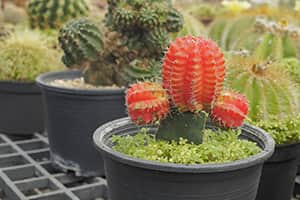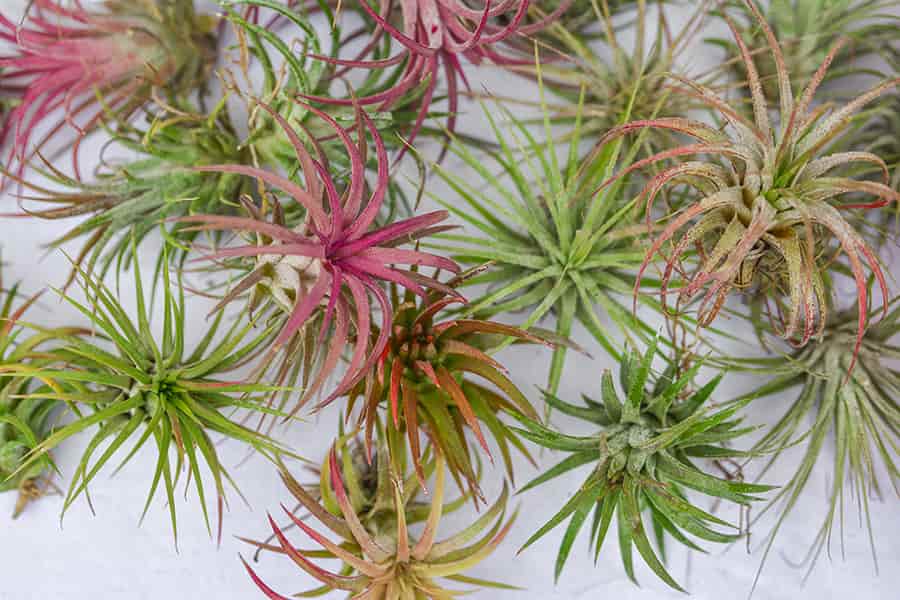Research shows that plants can improve focus and creativity, boost mood, and reduce stress and tiredness. Even city dwellers without a garden can benefit from some indoor greenery as caring for plants can work wonders for your health and wellbeing.
Indoor plants are one of the simplest and most affordable ways to spruce up your living space. Plus, their ability to remove pollutants from the air makes them great natural air fresheners.
One of the top reasons that people avoid bringing plants into their homes is worry that they won’t be able to care for them properly. But the good news is that there’s a range of indoor plants that are easy to look after and really quite hardy.
Here are 10 low-maintenance indoor plants that make great companions all year round.
1. Snake plant

Snake plants (also known as ‘mother-in-law’s tongue’) are spiky, have beautifully patterned leaves, and can be purchased in a range of different sizes – making them an interesting addition to your plant collection.
They’re native to tropical West Africa and require such minimal care that you can pretty much forget about them with little consequence.
The biggest challenge is actually avoiding over-watering them, so just make sure that you let the soil dry out in between watering if you want to avoid root rot. And while snake plants can survive in a variety of light conditions, they tend to prefer indirect sunlight.
When it comes to air purification, snake plants are on NASA’s list of top-rated indoor plants because of their ability to remove toxins, such as formaldehyde and benzene, from the air.
2. Ponytail palm tree

With its bulb-like trunk and lush, curly leaves, it’s easy to see why ponytail palm trees (or ‘elephant’s foot’) have become a popular choice of houseplant.
Looking after them is pretty simple too as they prefer to live in drier soil and only need watering occasionally (approximately every three to four weeks).
Originating from sunny Mexico, ponytail palm trees have also adapted to be able to live in drought conditions by storing water in their bulbous trunk. This is a perfect solution for anyone who’s ever felt extreme guilt over forgetting to water their leafy companion!
Ponytail palm trees will do just fine in a spot with partial shade, but you’re far more likely to see new growth if you can provide them with a decent amount of sunshine.
3. Peace lily

The peace lily is a vibrant, graceful plant that’ll add life to any indoor space.
Its stunning flowers feature a white, hood-like sheath – known as a spathe – which resembles a flag of surrender. The peace lily has long been used as a symbol of peace and hope, and is sometimes gifted to people who’re grieving the loss of a loved one.
These plants are great at telling you how they feel because they’ll droop slightly when they’re in need of water, and will revive quickly after a long drink. They also thrive in low-light conditions. Most serve as floor plants because they can grow to nearly a metre tall, and have big, bold leaves which means they also grow very wide.
Peace lilies are also on NASA’s top 10 list of houseplants that can effectively purify the air in your home. Just be sure to wipe the leaves with a soft, damp cloth every now and then to prevent their oxygen-releasing pores from becoming blocked.
Note: Peace lilies are highly poisonous to humans and animals if ingested, so it’s important to keep them away from children or house pets – or avoid them altogether if this isn’t possible.
4. ZZ plant

ZZ plants originate from Africa and have been around for centuries. They have dark, glossy leaves and look quite luxurious, but need surprisingly little TLC.
They do well in low light conditions and can go for long periods without being watered because their roots are particularly efficient at storing water. So, if you lead a busy life or are forgetful when it comes to watering your plants, you’ll be glad to know that ZZ plants only need a drink every couple of weeks – potentially even less in the winter.
For best results, try adding a balanced fertilizer to the water once a month. In the right conditions, a ZZ plant can grow up to a metre tall, so it’s best to make sure that you have the space to accommodate any growth spurts.
Note: All parts of the ZZ plant are poisonous to humans and animals if ingested, so be sure to keep them away from pets and children – or simply avoid them altogether if this isn’t possible.
5. Aloe vera plant

Aloe vera is a succulent that has vibrant, green, fleshy leaves with serrated edges, and either a short stem or no stem at all.
While aloe vera is an attractive and easy plant to care for, it’s also incredibly useful. The gel of aloe vera plants can be used to help heal mild scrapes and sunburns on the skin; and like some of the other plants on this list, NASA has named aloe vera as one of the top plants you can buy if you’re looking to purify the air in your home.
Aloe veras are best placed in a brightly lit window, but keep them out of direct sunlight if you want to avoid them turning yellow. Despite being a multi-functional plant, they’ll be perfectly happy with minimal watering, and be sure to only water them when the soil is completely dry.
6. Dracaena plant

If you’re looking for a houseplant with some height, a dracaena plant (also known as a ‘dragon tree’) is worth considering.
It’s native to Madagascar and Mauritius and the origins of its name come from the ancient Greek word drakaina or ‘female dragon’. This is because the stems produce a red, gum-like resin, which has been likened to a dragon’s blood.
Several centuries ago, it was used for dyes, toothpastes, and medicines – but today, it’s used for photoengraving and varnish. Dracaenas are also well known for their air-purifying abilities.
These plants are happiest in bright conditions, but their leaves can become burnt in direct sunlight. You should also wait until the top half of the soil is dry before watering, and choose a pot large enough for them to develop an extensive root system.
Note: This plant is toxic to animals, so should be kept away from any house pets, or avoided altogether if this isn’t possible.
7. Cactus

Bunny ears cactus

Moon cactus

Pincushion cactus
Cacti are hardy plants that can survive for hundreds of years in the right conditions.
There are over 2,000 species from around the world, though, some are easier to care for than others. If you’re a beginner, it’s worth considering varieties like moon cactus, bunny ears cactus, and pincushion cactus.
Cacti each look quite different, but all have flowering potential and care is straightforward. As long as they’re watered every three to four weeks, have a pot with good drainage to allow the soil to dry out fully in between waterings, and are positioned in bright light, they should live long lives.
8. Pothos plant

If you’ve never looked after a houseplant before, caring for a pothos plant (also known as ‘devil’s ivy’) is a good way to get started.
They’re virtually indestructible, require very little maintenance, and can thrive in a variety of settings from bright to low light – just avoid placing them in direct sunlight.
Pothos plants can live in most types of soil, and can even live in water. While these aren’t the fanciest plants in the world (they don’t flower and come in only a couple of varieties) their trailing stems and big green leaves can add a touch of green elegance to any home.
Note: Be aware that these plants are highly poisonous, so should never be ingested by humans or animals.
9. Air plants

These fuzzy, spidery-looking plants fit the nickname ‘air plants’ because they get most of their nutrients from the air around them – not from soil.
Air plants are low-maintenance and grow very short, thin, and shallow roots. Interestingly, they come from the same family as pineapples.
Air plants don’t live in soil and their roots are used purely to grab onto another host plant in the wild, which they use as an anchor (don’t worry, they don’t harm it). However, when buying indoor host plants, the roots will often have been removed because they won’t need to anchor to survive.
It’s up to you how you choose to display your air plant. Some people place them in pebbled pots or terrariums, while others just leave them sitting free on a windowsill.
Although air plants do get the majority of their nutrients from the air, they still need watering. The best way to do this is to use a spray bottle* to mist them a couple of times a week. They also do well in bright, but indirect, sunlight.
10. Rhipsalis plant

Rhipsalis, also known as ‘mistletoe cactus’, are bizarre plants that look as though they must have come from another planet. Most people don’t realise it, but rhipsalis are actually from the cactus family – they just look very different to most species of cactus.
Rhipsalis are fast growers and have messy tendrils which are darker green at the top and paler green near the bottom. Because of their long leaves, rhipsalis will often be placed in hanging pots and need virtually no maintenance.
They don’t shed, can cope with all light conditions (but do prefer a brighter spot), and only need watering roughly once a week. If the tendrils become too long, you can cut them back into shape without doing any harm to the plant as a whole.
Final thoughts...
Being a plant parent can be lots of fun. I’ve personally grown quite attached to my plants as I find that checking and caring for them gives me a lot of fulfilment – even if it’s only once a week.
I was terrible at looking after plants to start with and definitely over-watered them, but once I got the hang of it, it became very satisfying! Adding greenery to my living space has also boosted my mood and helped me to feel more positive.
The plants listed here are just some examples of ones you could adopt if you’re new to looking after indoor plants because they’re fairly low maintenance. But once you feel more confident, you could consider looking after plants that need more complex care – such as peacock plants, zebra plants, and venus fly traps.
For more inspiration, head over to the gardening section of our website. Here, you’ll find articles on everything from superfoods to grow at home to monthly gardening checklists.
What’s your experience with indoor plants? Have you got any additional easy-to-care-for plants that you’d recommend to others? We’d love to hear from you in the comments below.
